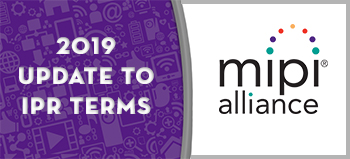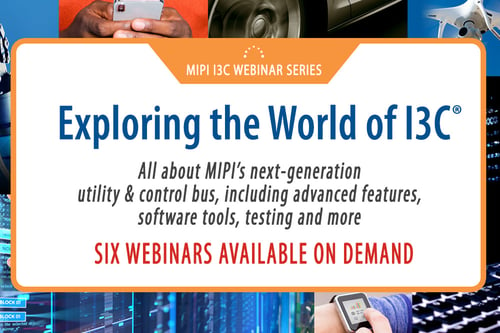5 min read
Building on 16 Years of Success: The 2019 Update to MIPI Alliance’s IPR Terms
![]() Brad Biddle, MIPI Counsel
:
8 August 2019
Brad Biddle, MIPI Counsel
:
8 August 2019

- News & Events
- News
- Blog
In January 2019, MIPI Alliance announced an update to its membership agreement that altered certain intellectual property-related terms. The update became effective for all members in March. This article explains the changes that were made and provides a general overview of MIPI Alliance’s approach to intellectual property.
Background: RAND, RF and MIPI Alliance’s historical hybrid model
Intellectual property rights (IPR) policies of technology consortia such as MIPI Alliance usually fall into one of two broad categories: RAND (reasonable and non-discriminatory) or RF (royalty free). Subject to various limitations and exceptions, RAND (also known as FRAND – fair, reasonable and non-discriminatory) policies require that parties commit to license certain patent claims that are unavoidably infringed by an implementation of a specification on reasonable and non-discriminatory—but potentially royalty-bearing—terms. RF policies (also known as RF-RAND, RAND-Z or RAND-Zero in some cases) require that parties license this limited set of claims on royalty-free terms.
MIPI Alliance launched in 2003 with a primary focus on the mobile phone industry. The MIPI founders chose an RF policy for this core focus area: The MIPI IPR terms required that members grant other members RF licenses in connection with MIPI specifications implemented in “Mobile Terminals” and “Accessories” (defined at length in the membership agreement, roughly with the meaning that the plain-English words suggest). Outside of this core focus area, the Alliance applied RAND terms among MIPI members.
Keeping pace with an evolving industry
Between 2003 and today, the mobile industry has undergone a fundamental transformation, and MIPI specifications have played a critical supporting role in this process. Key stakeholders from throughout the industry contributed to the development of MIPI specifications, and these specifications are now used ubiquitously in mobile devices. The evidence of the past 16 years demonstrates that the RF model worked effectively to enable the creation of high-quality specifications—known for low power demands, high bandwidth and low electromagnetic interference—and widespread adoption of these specifications in products throughout the mobile industry.
Over time, the technical quality and wide deployment of MIPI specifications attracted other industry segments to MIPI Alliance. Companies that planned implementations of MIPI specifications outside of traditional mobile phone-related products raised three recurring concerns about the MIPI IPR terms:
- Ambiguity about whether a product was an RF-licensed “Mobile Terminal” or “Accessory,” or was subject to RAND terms
Written in 2003, the definitions in the MIPI membership agreement increasingly had not correlated well to new products emerging in the market. Some members indicated that the associated uncertainty forced difficult decisions about whether to implement MIPI specifications in certain products. - Lack of transparency related to potential RAND licenses
Technology consortia with RAND policies frequently also include an obligation that any party intending to make license demands disclose this fact as part of the specification development process. MIPI Alliance’s policy did not include this disclosure requirement, and some members voiced concern that this created uncertainty about whether licenses would be required and what the potential costs might be. - Unfair treatment of certain industry segments
Members and prospective members from outside the mobile industry pointed out that a consequence of the hybrid model was that they were obligated to grant royalty-free licenses for the products of MIPI Alliance’s mobile-focused members, but these parties could still assert royalty demands against the products of the non-mobile-focused companies. This had the potential to unfairly shift the balance of power when companies were negotiating bilateral patent cross-license agreements, for example.
The MIPI Alliance Board of Directors heard these concerns over time and approved updating the MIPI IPR terms to address the needs of the changing industry and to facilitate the broader implementation of MIPI specifications.
The updated terms: Embracing the RF model
Ultimately MIPI Alliance settled on a straightforward solution. As updated this year, the terms eliminate the definitions of “Mobile Terminal” and “Accessory” altogether, and instead apply the historical RF terms to all types of product implementations. In other words, MIPI Alliance no longer has a hybrid policy, but rather has RF IPR terms that apply to all specification implementations.
The Alliance was able to draw from its 16-year history of successful specification development and deployment in the mobile industry to determine that the RF model worked effectively for its particular ecosystem.
In addition to the elimination of the “Mobile Terminal” and “Accessory” definitions, the 2019 update made one other change to the IPR terms. The terms have also always included an option for a patent owner to opt particular patent claims out from any licensing obligation, provided that they exercise this right prior to specification finalization (and subject to some other limitations). Historically this opt-out right was limited to a quota of two opt-outs in a five-year period. Opt-outs have been extremely rare; but to further reassure patent owners that their interests are protected, the updated terms now raise this quota to six opt-outs in a five-year period.
No other changes
Other than eliminating the “Mobile Terminal” and “Accessory” definitions and increasing the opt-out quota from two to six, no other changes were made to the terms. Accordingly, apart from these changes, the 2019 version of the membership agreement remains identical to the prior version.
The IPR terms continue to include important protections for patent owners. The licensing obligations imposed on patent owners under the MIPI IPR terms have always been strictly limited to claims that are essential (i.e., unavoidably infringed by a compliant implementation) and that fall within a tightly defined scope limited to “Interfaces” (as defined in detail in the membership agreement). Accordingly, the sweep of any RF obligation is limited to only what is strictly necessary to implement MIPI specifications, and other uses of patents by a patent owner are not encumbered by the MIPI terms.
Additionally, the patent licensing obligations continue to apply only to and only among MIPI members. Under the IP terms in the membership agreement, only members are obligated to grant licenses, and only members benefit from this license obligation. Alliance members are not obligated to grant patent licenses to non-members. If a party wishes to benefit from the RF terms, it must be a MIPI member.
Additional IPR terms for MIPI I3C Basic
Prior to the change to the MIPI IPR terms, the IPR challenges described above had become sharply acute in connection with one particular specification, MIPI I3C. To respond to these challenges, MIPI Alliance adopted MIPI I3C Basic, a publicly available version that is subject to a set of additional IPR terms.
In connection with I3C Basic, the usual MIPI Alliance IP rules continue to apply to and among members. However, those member companies that participated in the development of I3C Basic have additionally agreed to extend an RF licensing obligation to non-members in connection with implementations of I3C Basic, provided that the non-members commit to a reciprocal obligation. These terms are included in the I3C Basic specification document.
Guidelines for publicly available MIPI specifications
MIPI specifications are usually made available only to MIPI members. Occasionally, however, MIPI posts specifications publicly as required to meet unique industry needs. In these situations, MIPI grants downloaders a limited copyright license to enable the review and internal distribution of the specification. However, no patent licenses are granted or promised, as the MIPI IP policy obligates patent licensing only by and among members. If a non-member company intends to take any actions that potentially implicate patent rights, MIPI Alliance suggests that they join the organization to become beneficiaries of the RF patent license commitment from members.
As of the date of this post, I3C Basic v1.0 is the only publicly posted specification that includes a mechanism for extending patent licenses to non-members. All other public specifications are released under a copyright-only license.
A solid foundation for the future
MIPI Alliance helped to transform the mobile device industry and is now poised to have a similar impact on other industry segments, such as IoT and automotive. As MIPI has embarked on automotive activities, including the development a new longer-reach physical layer for automotive applications, alleviating IPR challenges and concerns has opened the door for greater involvement and participation from OEMs and Tier 1 suppliers. Those that join MIPI Alliance now also have the ability to leverage other MIPI specifications, such as CSI-2, DSI-2, C-PHY and D-PHY, under the same royalty-free model.
The updated IPR terms establish clear rules that apply equally to all MIPI member products, building on what has historically worked for the Alliance and providing a solid foundation for future success.






